Peter Flanagan, Head of Transformation, and Paul Warwick, Clinical Lead for CAMHS Inpatient Service at Humber Teaching NHS Foundation Trust describe how they co-designed their new inpatient service with young people and how it aligns with the THRIVE Framework for system change (Wolpert et al., 2019).
Download this implementation story.
Background
Humber Teaching NHS Foundation Trust have been commissioned by NHS England to provide a new 13 bedded CAMHS inpatient unit, which will include 9 general adolescent beds and a 4 bedded psychiatric intensive care unit (PICU) for the young people of Hull, East Riding of Yorkshire, North Lincolnshire and North East Lincolnshire.
The current CAMHS inpatient system can at times appear fragmented as the responsibility for commissioning, delivering and overseeing the services that support young people’s mental health can be provided by a number of different organisations. This can have a negative effect on the experience of the young person and their family as the systems often struggle to communicate, often leading to longer admission times.
Our local experience of using beds is that the fragmented nature of their commissioning, coupled with the current location of inpatient beds, can often result in young people feeling disconnected from the people who matter most to their recovery; with community systems describing a sense of loss of the young person, and inpatient units becoming frustrated that community mental health and well-being resources do not support the development of effective discharge support packages. These challenges can result in longer admission times, affect the outcomes of the admission and increase the frequency of future readmissions.
As part of the development of CAMHS Inpatient services ‘Young Minds’ were commissioned by NHS England North to engage with young people about the kind of services they want to see. From that engagement it was clear that the location, access and building design are key issues for young people. In respect of location they felt that inpatient services:
- Should ideally be no more than 30 minutes travel for families, however given the relative complexity of the cross-border nature of the Humber geography and the very real psychological barrier the Humber Bridge presents, parents understand this may not be possible
- Should be close to existing amenities/services
- Have adequate, free parking
- Have good transport links
Listening to this feedback we identified a site for the new service which is situated within a socially inclusive and mutually supportive neighbourhood that benefits from long standing community leadership from The Goodwin Trust who are committed to the improvement in quality of life of young people and adults. The location is within easy walking distance of Hull city centre, with outstanding transport links and amenities as well as in close proximity to the local acute hospital.
Planning for a new inpatient service
As an i-THRIVE Community of Practice member and not being an existing provider of CAMHS inpatient beds we have the opportunity to develop a fantastic new service that builds on the principles of the THRIVE Framework and works in partnership with the current community resources to offer a safe and containing environment to the most vulnerable young people, adding to the existing clinical formulation not rewriting it. This will allow established therapeutic relationships to continue which will achieve better and timelier clinical outcomes for the young person.
Working collaboratively with the community services to develop a comprehensive needs led package of care will allow the inpatient service to better predict the needs of young people and therefore allow the service to plan the most efficient use of the inpatient provision. This will offer a change to how inpatient units are traditionally viewed. The service will advocate shared decision making, a key principle of the THRIVE Framework, and the idea of “step in and step out” rather than “step up and step down”. This will help to change the perception of the service and encourage agencies to be truly invested in holistic needs-led care packages across all the needs based-groupings, whilst maintaining and sharing on going responsibility and accountability for the help and support provided across sectors.
To build on this thinking and prior to any planning or thought around how the unit might look we wanted to hear the voice of our young people, capture their experiences, and understand what is important to them if they were to be admitted to a CAMHS inpatient unit. We hosted events on two separate evenings to ask our young people “What does a fantastic CAMHS inpatient unit look and feel like for you?”. It was important that we remained impartial in this process so as not to influence the narrative. To achieve this we commissioned an independent Leeds based organisation ‘m-habitat’ to lead the events.
Across the two evenings we were joined by young people, parents, and professionals working with young people’s mental health, and a representative from the Department of Health who was working on the new Health Building Note (HBN) for CAMHS Inpatient units. It is important to add that not all the young people involved had experienced inpatient admission; however, all had experience of services that support their mental health. Although the events were run across two evenings the themes that arose were very similar:
- Location
- Mental health systems
- Staffing
- The types of activities
- Needing a reassurance that we will not create a “hospital”
The young people and parents spoke openly about their experiences, and were clear that the current system does not work for them. Starting with the very clear message of “Opposites”, “do the opposite of what you do now”. See visual depiction:
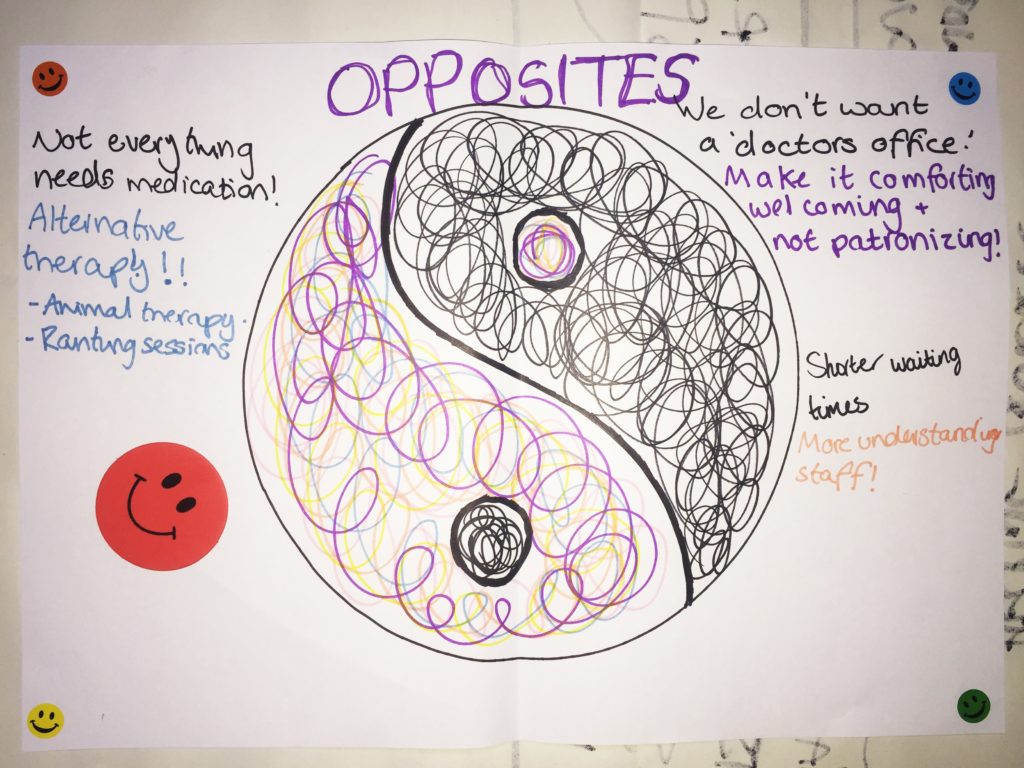
This theme continued across both evenings with the young people talking about access to services being very difficult. Some young people described a belief that they needed to present in a crisis for services to recognise that they are struggling and when a bed was required they then described the wait and how much pressure that put on their family.
Young people spoke of particular issues around the importance of needing to feel safe and felt that this was often provided by the staff working in the service. Many described instances of being supported by staff who seemed over worked and “burnt out”. They focused upon observation levels and described a system where young people were never left alone which can lead to an escalation in their difficulties whereas too little support can lead to them feeling alone and “suicidal”. Leaving us with a clear instruction to “Find the balance”. Young people felt that recruiting the right staff could be supported by involving young people in the recruitment process.
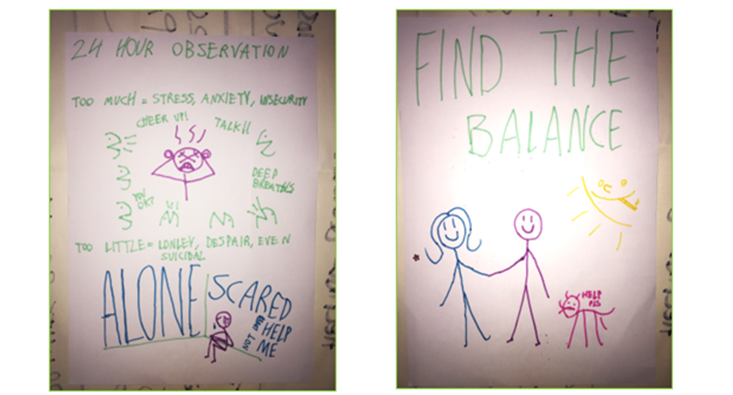
Clear messages around the service not looking too clinical and having a homely feel resonated throughout. Both parents and young people spoke of the issues around family visiting, often reporting on their being a lack of dedicated space for them and being fitted in rooms when they weren’t in use. Outdoor space was another consideration, reflecting that sometimes they encountered restrictions around using outdoor space due to staffing levels.
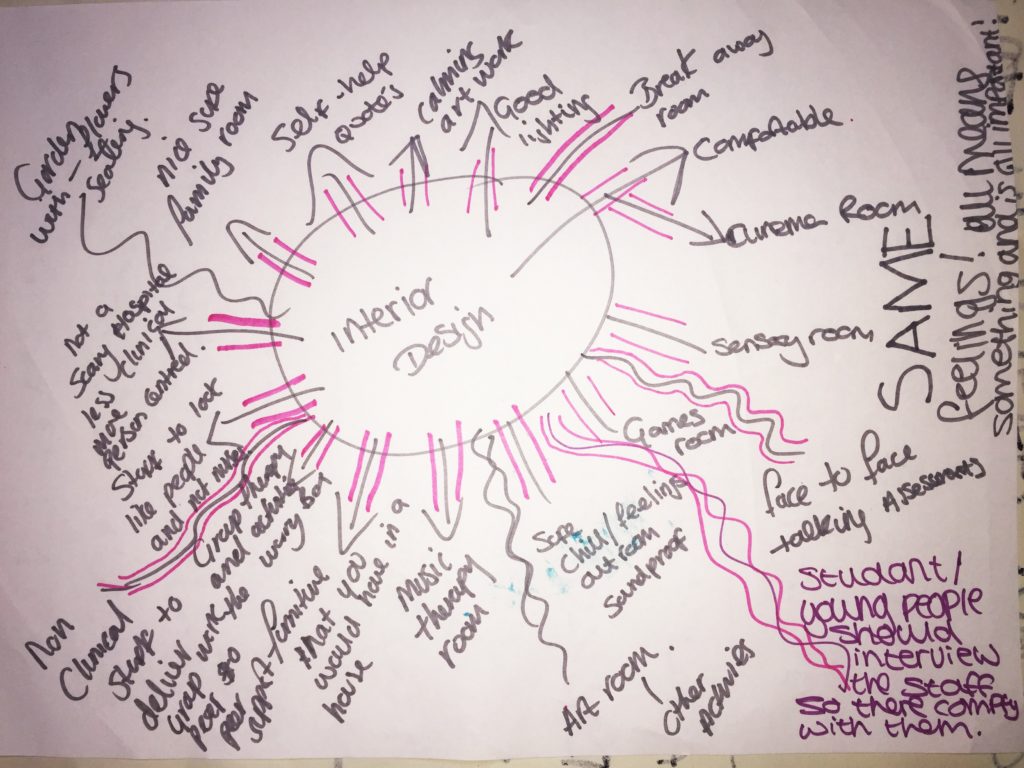
Learning from young people consultation:
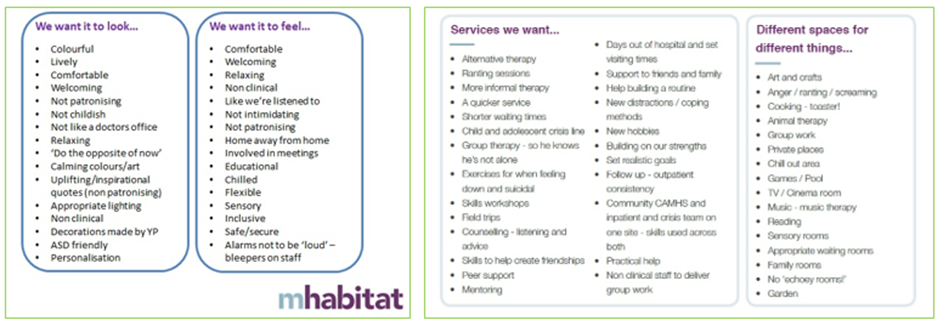
The current commissioning arrangement for young people’s mental health presents a very interesting challenge. For young people experiencing mental health distress it is often about their relationships with the system, with their family, their peers and with themselves, yet the current system does not serve to support those relationships. Young people want an inpatient service that responds to their needs rather than a service that is only available when the system prescribes it. They want an inpatient unit to be seen as part of the total offer of support for a young person and their family.
For them it’s simple:
“Just do the Opposite!”
Next steps: how we are taking this forward
Representatives from the Department of Health who were writing the new Health Building Note for Inpatient CAMHS (HBN 03-02) attended the event and were impressed by the richness and quality of the suggestions of the young people that they took some of the young people’s suggestions and have included them as a case presentation within the building note. Using one of their images on the front cover.
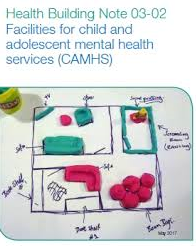
For the development of our service the discussions with young people have formed the building blocks of how we have approached this project, the young people’s voice and participation continues to have an ever strong presence in all aspects of the development of this new service.
If you would like further information, please contact Peter Flanagan at: peterflanagan@nhs.net or Paul Warwick at: pwarwick1@nhs.net.
Edited by the National i-THRIVE Programmme Team.
Written September 2018.